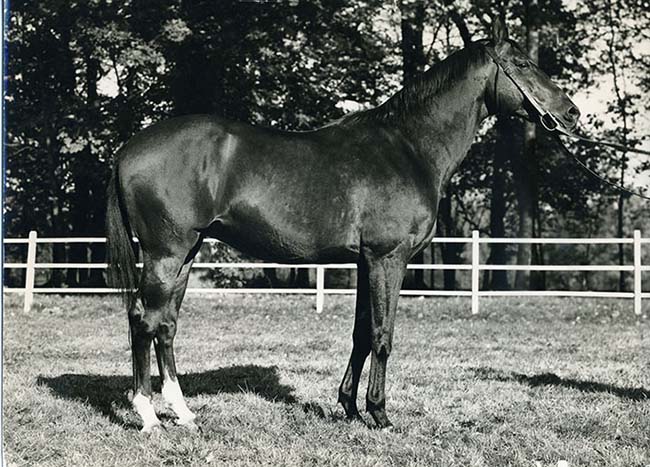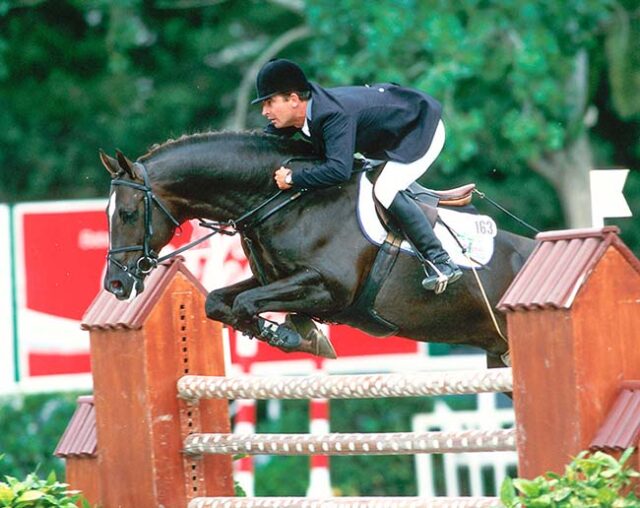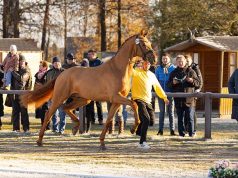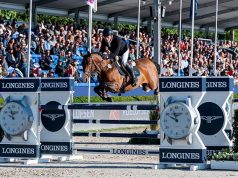By Adriana van Tilburg
Photography: Peter Llewellyn, Umberto Martuscelli, and courtesy ANAA
In the past stallions like Inschallah AA (Israel AA - Resena AA x Nithard AA), bred by Jacques Guicheny) and Ramzes AA (Rittersporn xx - Jordi x 532 Shagya X-3) have marked German Warmblood breeding. And in Belgium Garitchou AA (Nikou AA - Maritchou AA x Aiglon VII AA, Pierre Bouchet) and Et Hop AA (Pancho II AA - Tob de Fondelyn AA x Karikal IV AA, Philippe Caumont) have contributed substantially.
Plus the mares Ballerine III AA (Rantzau xx - Manuela AA x Labrador xx, bred by Baronne Empain and M.G. Calmon) and Ifrane AA (Chateau du Diable xx - Oita AA x Cidre Mousseux, breeder: Roland Gilberton). In this article I specifically refer to the breeders/studbooks from Belgium, France and Germany.
Origins linked to 19th century HN policy
The origin of the breed is linked to the policy pursued by the Haras Nationaux administration in the 19th century. Under the leadership of Raoul de Bonneval, then Antonin Laurent Chébrou de Lespinats, and later Eugène Gayot, the breed was created and took off. It is a combination of ‘pure Arabian blood’ (which was difficult to prove in the past), Oriental blood, Thoroughbred, and the old half-blood breeds of south-western France.
Originally intended for military purposes, the horse was then used for racing, and later for luxury and sport, with the studbook being established in 1833. According to a quote by Carl Gustav Wrangel, from the book Die Rassen des Pferdes: ihre Entstehung, geschichtliche Entwicklung und charakteristischen Kennzeichen, Volume 1, written in 1908: “The task of Anglo-Arabian breeding is to supply the market with a horse which combines the best qualities of the English and Arabian Thoroughbreds and which, in those regions where the mare materially requires a stallion closer to the Oriental type, without being so small and light as the product of pure Oriental breeding, can be used with greater advantage than the English Thoroughbred.”
The first crosses were carried out under the auspices of the Haras Nationaux (state stud farms in France, now part of the Institut français du Cheval), with the help of the directors of renowned Haras Nationaux such as the Haras du Pin and Pompadour. Subsequently, it was the Haras Nationaux of Pau and Tarbes that played an important role in the development of the breed, especially by supplying the armies of Napoleon I with horses. Thus, the south-west of France is generally considered to be the cradle of the Anglo-Arab breed.

Anglo Arab foundation bloodlines
Denousté ox (Latif ox - Djaïma ox x Khouri ox, breeder: Mr. Lalague), born in 1921 became a foundation stallion for the Anglo Arab breed, and is one of the most influential Arabian sires in the breed’s evolution. Another extraordinary stallion was the Anglo Arab Nithard AA (Kesbeth AA - Nitouche AA x Lotus VIII AA). Nithard AA was born in 1948 and stood at the Haras Nationaux de Pau from 1952 to 1968. He is the equivalent of Ibrahim for the Selle Français as he is so present in the origins of maternal and paternal Anglo Arab bloodlines.
Nithard’s most influential sons are Ventoux AA (sire of the private stallion Iago C AA), Alize AA, Samuel AA; Brick AA (sire of the mare Khadidja, who jumped 1m60); Rio Negro AA (sire of the stallion Faritchou AA); Urtois AA (sire of the stallions Fol Avril AA and Hadj A AA); Oracle AA; and Quilling AA.
Nithard AA was also the full brother of Nickel AA, a stallion of the Haras Nationaux de St-Lô who gave excellent broodmares in Normandy like the famous Bourrée (dam of Narcotique, P'Tit, Ulane du Plessis, Venus du Plessis, Flore du Plessis II, etc.). The well-known Selle Français stallion Quick Star (Galoubet A - Stella x Nithard AA), like Inschallah AA, also has Nithard AA as his damsire. The more recent NRPS-bred stallion Andiamo (Animo), who performed at 1m60 level, came from the AA-bred mare Taj Mahal AA (Garitchou AA - Joyeuse AA x Nithard AA).
More recently, the Anglo Arabian has claimed the spotlight once again thanks to the success of sport horses such as:
• Quenelle du Py AA (2004) – recorded good placings at CSI5*/CSI5*-W/CSIO5* as well as GCT classes with Olivier Robert (FRA);
• Upsilon AA (2008) – nine wins, three seconds, and one third place in just 18 outings at CCI3*/CIC3*/CICO3* with Thomas Carlile (FRA);
• Vassily de Lassos (2009) – Individual bronze at the Tokyo 2020 Olympic Games in 2021 with Australia’s Andrew Hoy;
• Vasnupied de Jonkiere AA (2009) – CSI4*/CSI5* with Charles Henri Ferme (FRA), and more recently with Marie Eugenie Angles (FRA);
• Prestige Kalone AA (2010) – CSI5*/CSIO3* with Canada’s Danielle Lambert, and previously CSI5*-W with Philippe Rozier (FRA);
• Quelstar du Vic Bilh (2004); CSI3* 1m50 with Alexandra Francart;
• Sherazade du Gévaudan (2006) – CSI5*/CSIO5*/CSI5* GCT/GCL with Swiss Romain Duguet, and good placings in 2019 wityh Sabrina Crotta (SUI) and Christiana Duguet (SUI);
• Ténarèze (2007) – CCI4*/CICO3* with Harry Meade (GBR), following excellent young-horse wins with Thomas Carlile (FRA) – three wins, two seconds, and one third out of six starts.
Anglo Arabians abroad: Ramzes AA
The most famous Anglo-Arab stallion in Germany is without doubt the 1937-born Ramzes AA, bred in Poland, by Marie Gräffin Plater-Zyberk. In Ramzes AA we find at least 28 times the Arabian stallion Bairactar – the famous ancestor of Weil (1813-1838), of Marbach breeding. He is also the foundation sire of the Amurath ox line.
Following a showjumping career he stood at stud in Holstein in 1951 and 1952, then again from 1959 to 1960. Meanwhile, he became known as a sire of Westfalian broodmares with many of his offspring doing particularly well in dressage up to Olympic level. Despite a small number of offspring, Ramzes AA really bred true-to-type, with broodmares from northern Germany producing outstanding showjumpers. Nowadays he is perhaps best known as Ramiro’s (Raimond) grandsire, and can be found in most Holstein pedigrees; also through Capitol I who has a double cross on Ramzes AA through Retina and Vase.
According to Harm Thormählen: “Ramzes AA made the horses nobler here in Holstein. He competed himself at 1m40 under the saddle of Heinz-Heinrich Brinckmann. That was right after WWII. What I really liked about Ramzes AA was that he was very intelligent, beautiful, and had performance quality. Ramzes AA stood not far away from our farm so we rode our mares to him. I think it’s outstanding that he jumped at that level and also passed on his intelligence, sportiness, and sensitivity. Without these qualities Capitol I would never have been able to produce so many sport horses. Capitol I has Ramzes AA perfectly balanced twice through his paternal and maternal sides: Once as the sire of Retina, who is the mother of Capitano; and once as the father of Vase, the mother of Capitol’s dam, Folia... To read the complete article you need to be a subscriber
CLICK HERE TO SUBSCRIBE TO BREEDING NEWS
SUBSCRIBERS CAN READ THE COMPLETE ARTICLE BY LOGGING IN AND RETURNING TO THIS PAGE




